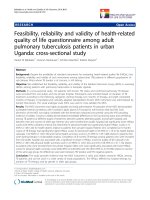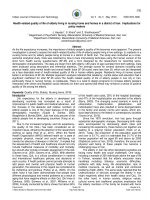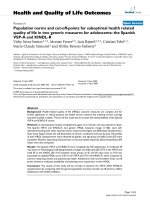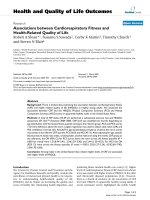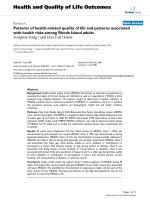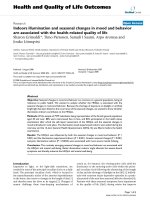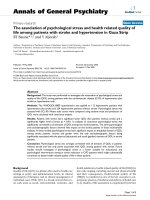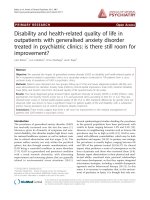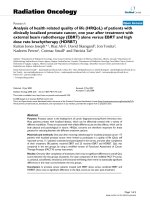Health related quality of life and some associated factors among the elderly living in three communes of ha nam province, 2019
Bạn đang xem bản rút gọn của tài liệu. Xem và tải ngay bản đầy đủ của tài liệu tại đây (314 KB, 9 trang )
JOURNAL OF MEDICAL RESEARCH
HEALTH - RELATED QUALITY OF LIFE AND SOME
ASSOCIATED FACTORS AMONG THE ELDERLY LIVING IN
THREE COMMUNES OF HA NAM PROVINCE, 2019
Tran Quynh Anh, Pham Thi Thu Trang , Do Vu Minh Ha
School of Preventive Medicine and Public Health
Caring for an aging population is an emerging public health problem, and the quality of life (QoL) among
the elderly is a significant concern. Our study aimed to describe the health - related quality of life (HRQoL) and
factors associated with good HRQoL among the elderly in three communes of Hanam province in Vietnam.
A cross - sectional design was used with a sample size of 479 participants aged 60 and above. HRQoL was
measured using the SF - 36. Comparison of characteristics between those with high HRQoL and those with
low HRQoL was done using Pearson chi - square tests. Results were reported using descriptive statistics
and odds ratios with 95% CI (Confidence Interval). Many of the elderly had moderate HRQoL (41.3%),
and elderly men were more likely to have higher QoL in terms of physical health and psychological health
than elderly women. Our findings also indicated that some factors including older age, low educational
level, those not living with their spouse, poor financial condition, having more than two health problems
and possessing unhealthy drinking behaviors were significantly positive associated with HRQoL. Findings
suggest interventions are needed to improve the quality of life among the elderly in rural areas of Vietnam.
Keywords: Health - related Quality of Life, HRQoL, elderly, associated factors.
I. INTRODUCTION
Improving the Health - related Quality of
Life (HRQoL) among the elderly is a significant
problem in caring for the aging population in
may countries in the world. HRQoL is a multi
- dimensional concept that includes domains
related to physical, mental, emotional, and
social functioning. It goes beyond direct
measures of population health, life expectancy,
and causes of death, and focuses on the impact
health status has on quality of life.
Worldwide, there have been many studies
conducted on HRQoL of the elderly showing
low and average HRQoL overall mean scores,
ranging from 40 to 50, in Taiwan2, Italy3 with
Corresponding author: Tran Quynh Anh,
School of Preventive Medicine and Public Health
Email:
Received: 05/04/2021
Accepted: 20/05/2021
JMR 141 E8 (5) - 2021
selection of elderly subjects from four programs
to achieve heterogeneity in the “health status”,
“functional capacity”, “gender”, and “age”
variables. The Clinical Impact Method was
used, consisting of the spontaneous and
elicited selection by the respondents of relevant
items to the construct Quality of Life in Old Age
from a previously elaborated item pool. The
respondents rated each item’s importance
using a 5 - point Likert scale. The product of
the proportion of elderly selecting the item as
relevant (frequency, and Spain.4 As Vietnam
confronts the challenge stemming from a
growing aging population, the importance of
HRQoL for the elderly becomes apparent,
and recently, more attention has been paid to
the topic. According to results from Vietnam
Population Change and Family Planning Survey
in 2016, the aging index had increased from
18.2% in 1989 to 50.1% in 2016. These showed
81
JOURNAL OF MEDICAL RESEARCH
that the population aging in Vietnam had been
growing very fast over three decades11.
Some of studies in Viẹtnam that can be
mentioned are a study of Luong et al. in Hai
Duong province5, study of Thang N. et al. in Thai
Binh province.6 A study in 2017 reported that
HRQoL score among the people in Thuy Van
commune of Thua Thien - Hue province was
moderate at 56.8. HRQoL positively associated
with age, education status, economic status,
marital status, health problems.7
following formula with the assumption that 10%
of the recruited would decline to partipate in the
study.
In the formula above, p is the prevalence
of the participants who had good HRQoL
according to the study conducted on the elderly
living in three communes of Thai Binh province
using the Short Form (36) Health Survey (SF
- 36) questionnaire in 2017, which is equal to
0.179 6; Z = 1.96; and = 0.15.
The minimum sample size was estimated to
In recent years, although the physical and
spiritual life of the elderly has improved, there
are still many challenges in terms of HRQoL
among older Vietnamese people. One reason
is a lack of evidence to design and implement
relevant policies and intervention programs to
improve HRQoL for seniors.8 There were very
few studies conducted on HRQoL among the
elderly, especially among those who are living
in rural areas in general and northen rural areas
in particular.
Therefore, this study was conducted to
describe the HRQoL among the elderly living
in three communes in Hanam province in 2019
and identify the factors associated with high/low
HRQoL?.
be 440 participants, and a total of 479 people
were enrolled in the study.
II. METHOD
1. Subjects
This study used a cross - sectional study
design and the eligible participants were people
aged 60 or older living in Dong Du commune
of Binh Luc district, Thuy Loi commune of Kim
Bang district or Chau Giang commune of Duy
Tien district. The participants were recruited
by using convenience sampling method. We
chose all people who aged 60 years and above
had been living in three communes for more
than three years.
The sample size was calculated using the
82
2. Method
Instrument and data collection
The health of the participants was measured
using SF - 36, which consisted of 36 items
divided into eight sections. The eight sections
measured vitality, physical functioning, bodily
pain, general health perceptions, physical role functioning, emotional - role functioning,
social role functioning, and mental health. Each
participant answered the questions in the eight
sections and received eight scaled scores,
which were the weighted sums of the questions
in each section. Information collected about
the socio - demographic characteristics of the
participants included age, gender, religion,
education, marital status, occupation, financial
status and health problems. Current use of
alcohol was assessed using the Alcohol Use
Disorders Identification Test–C (AUDIT - C)
which was a 3 - item alcohol screening tool that
helped identify persons who were hazardous
drinkers or had active alcohol use disorders
(including alcohol abuse or dependence).
3. Statistical analysis
Data were cleaned and checked for extreme
and illogical data before entered into a Epidata
database version 3.1. Data were converted
into .dta file and analyzed using Stata software
JMR 141 E8 (5) - 2021
JOURNAL OF MEDICAL RESEARCH
version 14.1. The whole eight sections of SF - 36 were scored on a scale of 0 to 100 with higher
scores indicating better HRQoL. A section was treated as missing when more than 20% of its items
were left blank. Descriptive statistics and odds ratios with 95% CI (Confidence Interval) were used
to report results.
4. Ethical considerations
All participants were informed that their participation was completely voluntary and were assured
that their responses would remain anonymously. All personal identifications of the participants were
protected. The survey was performed with agreement and authorization from the Directors of Hanam
Department of Health.
III. RESULTS
Among 479 participants, 55.3% were women and 44.7% were men; 45.7% were aged 60 - 69
years, 34.7% were aged 70 - 79 years, and 19.7% were over 80 years old. The majority (61.4%)
were farmers/workers, married (75.4%) and had moderate income or less (91.0%). Most (88%) of
the participants had high school education or lower, and the prevalence of illiteracy was 7.5%. All
sociodemographic characteristics were presented in Table 1.
Table 1. General information about participants
Characteristics
Classifications
Gender
Age group
Religions
Marital status
Education level
JMR 141 E8 (5) - 2021
Total
n
%
Male
214
44.7
Female
265
55.3
60 - 69
219
45.7
70 - 79
166
34.7
≥ 80
94
19.6
No religion
280
58.5
Buddhism
140
29.2
Christian
49
10.2
Others
10
2.1
Not living with spouses
118
24.6
Living with spouses
361
75.4
No education
36
7.5
Secondary school level
or less
378
78.9
Senior high school
44
9.2
University and posture
21
4.4
83
JOURNAL OF MEDICAL RESEARCH
Characteristics
Classifications
Occupation
Financial status
Alcohol use
Health risk behaviors
Tobacco use
Total
n
%
Unemployees
25
5.2
Freelancers
57
11.9
Government officers
82
17.1
Workers/Farmers
294
61.4
Others
21
4.4
Poor
322
67.2
Middle
149
31.1
Rich
8
1.7
Using
104
22.1
Not using
375
77.9
Using
103
21.5
Not using
376
78.5
Table 2 presented the proportions of participants with very low to high physical health, mental
health and HRQoL, stratified by gender.
Table 2. Health - related quality of life among participants
Male
Physical health
Mental Health
HRQoL
Female
Total
%
Very low
24
11.2
45
17
69
14.3
Low
50
23.4
92
34.7
142
29.7
Moderate
82
38.3
83
31.3
165
34.5
High
58
27.1
45
17.0
103
21.5
Very low
1
0.5
7
2.6
8
1.7
Low
36
16.8
55
20.8
91
19.0
Moderate
69
32.2
93
35.1
162
33.8
High
108
50.5
110
41.5
218
45.5
Very low
5
2.3
15
5.7
20
4.2
Low
50
23.4
79
29.8
129
26.9
Moderate
85
39.7
113
42.6
198
41.3
High
74
34.6
58
21.9
132
27.6
Regarding physical health, those with moderate and high level accounted for 34.5% and 21.5% of
the participants, respectively, while 14.3% and 29.7% had very low and low level of physical health,
respectively. The proportion of males who had moderate physical health score were the highest at
38.3%. Meanwhile, about a third (34.7%) of the women had low physical health score.
84
JMR 141 E8 (5) - 2021
JOURNAL OF MEDICAL RESEARCH
Regarding mental health, 45.5% had high score, 33.8% had moderate score, and only 1.67%
had very low score. There was no significant difference between men and women in terms of mental
health level (p>0.05).
Regarding HRQoL classification, 27.6% had high HRQoL, 41.3% had moderate HRQoL, and
26.9% had low HRQoL. Few (4.2%) had very low HRQoL. The proportion of males with high HRQoL
was higher than females (34.6% vs 21.9%, respectively). By way of contrast, the proportion of
females with low HRQoL was higher than males (29.8% vs 23.4%, respectively), similar to very low
HRQoL (5.7% vs 2.3%, respectively)
Table 3. Factors associated with HRQoL among participants
Characteristics
Age group
Gender
Educational
level
Marital status
Religion
Occupation
Financial
status
Health status
Unhealthy
alcohol use
Good
Not good
HRQoL
HRQoL
OR (95%CI)
n
%
n
%
60 – 69
171
78.1
48
21.9
70 – 79
110
66.3
56
33.7
1.8 (1.07 – 3.04)
≥ 80
49
52.1
45
47.9
3.3 (1.92 – 5.59)
Male
159
74.3
55
25.7
Female
171
64.5
94
36.5
Junior high school and above
52
80
13
20
Senior high school or less
278
67.2
136
32.8
Living with spouses
261
72.3
100
27.7
Not living with spouses
69
58.5
49
41.5
No religion
194
69.3
86
30.7
Having religion
136
68.3
63
31.7
Having occupation
315
69.4
139
30.6
No occupation
15
60
10
40
Not poor
125
79.6
32
20.4
Poor
205
63.7
117
36.3
< 2 health problems
224
73.7
80
26.3
≥ 2 health problems
106
60.6
69
39.4
No
268
66.7
134
33.3
Yes
62
80.5
15
19.5
1.6 (1.07 – 2.37)
1.95 (1.02 – 3.7)
1.85 (1.2 – 2.9)
1.05 (0.7 – 1.5)
1.51 (0.66 –
3.45)
3.0 (1.37 – 5.56)
1.82 (1.22 –
2.72)
2.2 (1.13 – 3.77)
Table 3 presented factors associated to HRQoL. Higher age groups were significantly associated
with increased odds of having worse HRQoL; participants in the age group 70 - 79 years old and age
group 80 years old or older were 1.8 (95% CI: 1.07 – 3.04) and 3.3 (95% CI: 1.92 – 5.59) times more
JMR 141 E8 (5) - 2021
85
JOURNAL OF MEDICAL RESEARCH
likely to have poor HRQoL than those in the age
group 60 - 69 years old. Women were 1.6 (95%
CI: 1.07 – 2.37) times more likely to have poor
HRQoL compared to men. Participants who had
senior high school education or lower were 1.95
(95% CI: 1.02 - 3.7) times more likely to have
poor HRQoL than those with junior high school
education. Other factors significantly associated
with HRQoL were having poor financial status,
not living with spouse, having more than 2
health problems, and having unhealthy drinking
men in all SF - 36 scales. In a sample of 1688
individuals aged 18 years or older, Li et al. found
lower scores among women in the following
dimensions: Physical functioning, Bodily pain,
General health and Vitality.20 Another study by
Wyss et al. in Tanzania reported similar results,
with women obtained lower scores than men
in all SF - 36 scales.21 Our finding was also
consistent with those from the study conducted
by Nilsson on QoL of seniors in a rural area of
Bangladesh9 and another study implemented
behaviors.
in FilaBavi, Vietnam.10 This suggests it is
important to understand factors affecting the
QoL in each gender in order to better inform
the interventions to reduce gender disparity in
HRQoL at old age.
As shown in Table 3, higher age groups were
significantly associated with lower HRQoL.
These results were similar to the findings by
Damayanthi et al. in 201814; Campos et al. in
201422; and Raggi et al. in 20164. Unsurprisingly,
elderly living in better economic condition had a
higher HRQoL than others. This result supports
previous studies in that elderly with higher
income had a better QoL.23 According to Fleck
et al., levels of income and education, good
living conditions and health, a good network
of friends, the maintenance of good family
relationships were factors that could contribute
to higher quality of life, subjective welfare, a
sense of self - efficacy, and thus for a better
overall functioning of the elderly24. We were
able to confirm that elderly individuals living
with spouses reported a better HRQoL than
those with no spouses. These findings were
similar with results of Lima et al.25; Nam et al.7;
Hoi et al.8
Our finding that those with two or more
health problems had higher odds of having
poor HRQoL was in line with another study
in Zimbabwe which reported chronic health
IV. DISCUSSION
Our results revealed that most of the
participants had moderate HRQoL. This was
consistent with results from a 2018 study
conducted in Tien Hai district of Thai Binh
province and Thanh Binh district of Dong Thap
province. In that study, the mean score of
HRQoL was on moderate level.6
Our findings showed that having poor
financial status, not living with spouse, having
more than 2 health problems, and having
unhealthy drinking behaviors were significantly
associated with HRQoL. These results were
consistent with previous research. Several
investigations have shown that socio demographic variables, health problems and
health behaviors such as tobacco use can affect
SF - 36 scores. Recent studies have indicated
that HRQoL domain scores among the elderly
are influenced by socio - demographic variables
such as age11,12, gender13, 14, marital status15,
16
, education level17 and economic condition.18
A study conducted among 316 elderly people
randomly selected in Tan An commune, Hai
Duong province, Vietnam, showed that age
groups, health status, family status and income
sources19 were related to quality of life.
By analyzing HRQoL stratified by gender,
this study showed that women were worse than
86
JMR 141 E8 (5) - 2021
JOURNAL OF MEDICAL RESEARCH
conditions significantly affected HRQoL among
grandparents 26. Wang R. et al in a study
conducted on the elderly living in Shanghai
city suggested that the primary influencing risk
factors of HRQL included chronic diseases,
age, frequency of activities, and geographical
region.28 Campbell et al., which indicated that
there was a significant relationship between
tobacco use and HRQoL among clients in
substance use disorders treatment.27
Our study paves the ways for further
doi:10.1186/1471 - 2458 - 11 - 546
3. Paschoal SMP, Filho WJ, Litvoc J.
Development of Elderly Quality of Life Index
4. – Eqoli: Item Reduction and Distribution
into Dimensions. Clinics. 2008;63(2):179 - 188.
5. Raggi A, Corso B, Minicuci N, et al.
Determinants of Quality of Life in Ageing
Populations: Results from a Cross - Sectional
Study in Finland, Poland and Spain. PLoS One.
2016;11(7). doi:10.1371/journal.pone.0159293
6. Duong Huy Luong. Nghiên cứu chất
examination of HRQoL in the elderly and provides
evidence for planning policies and programs
that enhance quality of life and decrease burden
of diseases for the elderly. However, due to the
cross - sectional nature, which cannot ascertain
the temporal relationship between HRQoL and
the significant factors found in this study, it is
difficult to make any causal inference that low
HRQoL was directly caused by these factors.
Studies with prospective longitudinal design
should be conducted to address this issue.
lượng cuộc sống người cao tuổi và thử nghiệm
giải pháp can thiệp ở huyện Chí Linh, tỉnh Hải
Dương. Luận án tiến sĩ y học-Học viện Quân Y
2010
7. Thắng NT, Vũ T, Kỷ HT, Hương LTT, Anh
LV. Quality of life of elderly people in Tien Hai district,
Thai Binh Province and Thanh Binh district, Dong
Thap Province in 2018. Vietnam Journal of Public
Health. No. 47 2019 p.39-46
8. Nhi NTH, Khanh DVD. Quality of life and
associated factors among the elderly in Huong
So ward, Hue City, Thua Thien-Hue Province.
Vietnam Journal of Preventive Medicine. 2019.
29 (11): 254
9. Hoi L, Chuc N, Lindholm L. Health
- related quality of life, and its determinants,
among older people in rural Vietnam. BMC
public health. 2010;10:549. doi:10.1186/1471 2458 - 10 - 549
10. Nilsson J, Grafström M, Zaman S,
Kabir ZN. Role and function: Aspects of quality
of life of older people in rural Bangladesh.
Journal of Aging Studies. 2005;19(3):363 374. doi:10.1016/j.jaging.2004.07.006
11. Hoi LV, Chuc NT, Lindholm L. Health
related quality of life, and its determinants,
among older people in rural Vietnam. BMC
Public Health. 2010;10:549. doi:10.1186/1471 2458 - 10 - 549
12. Huong NT,Ha LTH,TienTQ. Determinants
V. CONCLUSION
Most of elderly people had moderate
HRQoL, in which male elderly was more likely
to have higher level of QoL in physical health
and psychological health compared to female
elderly. Older age, low educational level, not
living with spouses, poor economic condition,
having more than two health problems and
having unhealthy drinking behaviors were
significantly associated with increased odds of
lower level of HRQoL.
REFERENCES
1.
GSO. Population and Housing Census
2019.; 2019.
2. Ho T - J, Christiani DC, Ma T - C, et
al. Effect of Qigong on quality of life: a cross sectional population - based comparison study
in Taiwan. BMC Public Health. 2011;11(1):546.
JMR 141 E8 (5) - 2021
87
JOURNAL OF MEDICAL RESEARCH
of Health - Related Quality of Life Among Elderly:
Evidence From Chi Linh Town, Vietnam. Asia
Pac J Public Health. 2017;29(5_suppl):84S 93S. doi:10.1177/1010539517704041
13. Tajvar M, Arab M, Montazeri A.
Determinants of health - related quality of life
in elderly in Tehran, Iran. BMC Public Health.
2008;8(1):323. doi:10.1186/1471 - 2458 - 8 323
14. Ćwirlej - Sozańska A, Sozański
B, Wiśniowska - Szurlej A, Wilmowska -
older adults. International Nursing Review.
2009;56(1):109 - 115. doi:10.1111/j.1466 7657.2008.00671.x
21. Tra LTM, Quang NV, Duc TQ. Quality
of life and some associated factors among the
elderly in An Nhon town, Binh Dinh Province
in 2017. Journal of Health and Development
Studies. 2(3)-2018 p.31-38
22. Li L, Wang HM, Shen Y. Chinese SF - 36
Health Survey: translation, cultural adaptation,
validation, and normalisation. J Epidemiol
Pietruszyńska A. Quality of life and related
factors among older people living in rural areas
in south - eastern Poland. Ann Agric Environ
Med. 2018;25(3):539 - 545. doi:10.26444/
aaem/93847
15. Damayanthi HDWT, Moy FM, Abdullah
KL, Dharmaratne SD. Health related quality of
life and its associated factors among community
16. dwelling older people in Sri Lanka: A
cross - sectional study. Archives of Gerontology
and Geriatrics. 2018;76:215 - 220. doi:10.1016/j.
archger.2018.03.009
17. Martinez - Martin P, Prieto - Flores M - E,
Forjaz MJ, et al. Components and determinants
of quality of life in community - dwelling older
adults. Eur J Ageing. 2012;9(3):255 - 263.
doi:10.1007/s10433 - 012 - 0232 - x
18. Del Core MA, Ahn J, Wukich DK, et
al. Gender Differences on SF - 36 Patient Reported Outcomes of Diabetic Foot Disease.
Int J Low Extrem Wounds. 2018;17(2):87 - 93.
doi:10.1177/1534734618774664
19. Knesebeck OVD, Wahrendorf M, Hyde
M, Siegrist J. Socio - economic position and
quality of life among older people in 10 European
countries: results of the SHARE study. Ageing
& Society. 2007;27(2):269 - 284. doi:10.1017/
S0144686X06005484
20. Paskulin L, Vianna L, Molzahn AE.
Factors associated with quality of life of Brazilian
Community Health. 2003;57(4):259 - 263.
doi:10.1136/jech.57.4.259
23. Wyss K, Wagner AK, Whiting D, et
al. Validation of the Kiswahili version of the
SF - 36 Health Survey in a representative
sample of an urban population in Tanzania.
Qual Life Res. 1999;8(1 - 2):111 - 120.
doi:10.1023/a:1026431727374
24. Campos ACV, e Ferreira EF, Vargas
AMD, Albala C. Aging, Gender and Quality
of Life (AGEQOL) study: factors associated
with good quality of life in older Brazilian
community - dwelling adults. Health and Quality
of Life Outcomes. 2014;12(1):166. doi:10.1186/
s12955 - 014 - 0166 - 4
25. Colet C de F, Mayorga P, Amador TA.
Educational level, socio - economic status
and relationship with quality of life in elderly
residents of the city of Porto Alegre/RS, Brazil.
Brazilian Journal of Pharmaceutical Sciences.
2010;46(4):805 - 810. doi:10.1590/S1984 82502010000400023
26. Souza JCRP de, Barros NH de S. A
avaliaỗóo de qualidade de vida: guia para
profissionais da saúde. Rev psiquiatr Rio Gd
Sul. 2008;30(1):89 - 90. doi:10.1590/S0101 81082008000100019
27. Lima MG, Barros MB de A, César
CLG, Goldbaum M, Carandina L, Ciconelli RM.
Health related quality of life among the elderly:
88
JMR 141 E8 (5) - 2021
JOURNAL OF MEDICAL RESEARCH
a population - based study using SF - 36 survey.
Cad Saúde Pública. 2009;25(10):2159 - 2167.
doi:10.1590/S0102 - 311X2009001000007
28. Mhaka - Mutepfa M. Sociodemographic
Factors and Health - Related Characteristics
That Influence the Quality of Life of Grandparent
Caregivers in Zimbabwe: Gerontology and
Geriatric Medicine. Published online February
13, 2018. doi:10.1177/2333721418756995
29. Campbell B, Yip D, Le T, Gubner N,
Guydish J. Relationship between Tobacco
JMR 141 E8 (5) - 2021
Use and Health - Related Quality of Life
(HRQoL) among Clients in Substance Use
Disorders Treatment. J Psychoactive Drugs.
2019;51(1):48 - 57. doi:10.1080/02791072.201
8.1555651
30. Wang R, Wu C, Zhao Y, et al. Health
related quality of life measured by SF 36:
a population - based study in Shanghai,
China. BMC Public Health. 2008;8:292.
doi:10.1186/1471 - 2458 - 8 - 292
89

